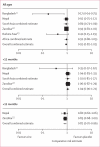Effect of daily zinc supplementation on child mortality in southern Nepal: a community-based, cluster randomised, placebo-controlled trial
- PMID: 17920918
- PMCID: PMC2376970
- DOI: 10.1016/S0140-6736(07)61539-6
Effect of daily zinc supplementation on child mortality in southern Nepal: a community-based, cluster randomised, placebo-controlled trial
Abstract
Background: Zinc supplementation can reduce subsequent morbidity in children recovering from diarrhoea and respiratory illness in developing countries. However, whether routine supplementation would decrease morbidity and mortality in populations with zinc deficiency is unclear. We assessed the effect of daily zinc supplementation on children in southern Nepal.
Methods: We did a community-based, cluster-randomised, double-masked, placebo-controlled, 2x2 factorial trial in children aged 1-35 months. Treatment groups were placebo, iron and folic acid, zinc, and iron and folic acid with zinc, with daily doses of 12.5 mg iron, 50 microg folic acid, and 10 mg zinc. Study staff gave children tablets on 2 days each week and left tablets with caregivers for other days. All children received vitamin A supplementation twice per year. Results of the iron arm of the trial have been reported previously. Between October, 2001, and January, 2006, 41,276 children were enrolled into the placebo (n=20,308) or zinc (n=20,968) groups and were followed-up for 60,636.3 person-years. The primary outcome was child mortality, and analyses were by intention to treat. Daily reports of signs and symptoms of common morbidities in stratified random subsamples of children were assessed every week for 12 months. This study is registered at ClinicalTrials.gov, number NCT00109551.
Findings: 2505 children refused to continue the trial and 3219 children were lost to follow-up. There was no significant difference in mortality between the zinc and placebo groups (316 vs 333 deaths; hazard ratio 0.92, 95% CI 0.75-1.12). Zinc had no effect on mortality in children younger than 12 months (181 vs 168 deaths; 1.04, 0.83-1.31); mortality was lower, but not statistically significantly so, in older children receiving zinc (135 vs 165; 0.80, 0.60-1.06). The frequency and duration of diarrhoea, persistent diarrhoea, dysentery, and acute lower respiratory infections did not differ between the groups.
Interpretation: Total mortality of children receiving zinc supplementation was not significantly different from that of children receiving placebo. Further data are needed from other populations with endemic zinc deficiency to confirm the potential age-specific effects reported in this study.
Figures
Comment in
-
Effect of zinc supplementation on child mortality.Lancet. 2007 Oct 6;370(9594):1194-5. doi: 10.1016/S0140-6736(07)61524-4. Lancet. 2007. PMID: 17920908 No abstract available.
References
-
- Black RE, Morris SS, Bryce J. Where and why are 10 million children dying every year? Lancet. 2003;361:2226–34. - PubMed
-
- Fishman S, Caulfield LE, de Onis M, et al. Childhood and maternal underweight. In: Ezzati M, Lopez AD, Rodgers A, Murray CJL, editors. Comparative quantification of health risks: global and regional burden of disease attributable to selected major risk factors. World Health Organization; Geneva: 2004. pp. 39–162.
-
- Rice AL, West KP, Black RE. Vitamin A deficiency. In: Ezzati M, Lopez AD, Rodgers A, Murray CJL, editors. Comparative quantification of health risks: global and regional burden of disease attributable to selected major risk factors. World Health Organization; Geneva: 2004. pp. 211–56.
-
- Caulfield L, Black RE. Zinc deficiency. In: Ezzati M, Lopez AD, Rodgers A, Murray CJL, editors. Comparative quantification of health risks: global and regional burden of disease attributable to selected major risk factors. World Health Organization; Geneva: 2004. pp. 257–80.
-
- Sempertegui F, Estrella B, Correa E, et al. Effects of short-term zinc supplementation on cellular immunity, respiratory symptoms, and growth of Equadorian children. Eur J Clin Nutr. 1996;50:42–46. - PubMed
Publication types
MeSH terms
Substances
Associated data
Grants and funding
LinkOut - more resources
Full Text Sources
Medical




